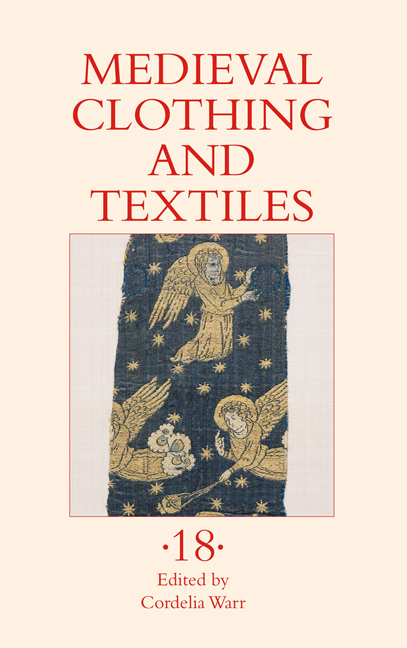Book contents
- Frontmatter
- Contents
- Illustrations
- Tables
- Contributors
- Preface
- 1 Linen Armour in the Frankish Countries: The Twelfth Century
- 2 Serial Production and Individualisation in Late Medieval Silk Weaving
- 3 The Trousseau of Isabella Bruce, Queen of Norway (The National Archives, Kew, DL 25/83)
- 4 Make and Create: The Craftswomen in the Salone Frescoes of the Palazzo della Ragione, Padua
- 5 Combs, Mirrors, and Other Female Beauty Bling in the Later Middle Ages
- 6 The Dividing Lines of Social Status in Sixteenth-Century Scottish Fashion
- Recent Books of Interest
- Author Index, Volumes 1–17
5 - Combs, Mirrors, and Other Female Beauty Bling in the Later Middle Ages
Published online by Cambridge University Press: 10 May 2024
- Frontmatter
- Contents
- Illustrations
- Tables
- Contributors
- Preface
- 1 Linen Armour in the Frankish Countries: The Twelfth Century
- 2 Serial Production and Individualisation in Late Medieval Silk Weaving
- 3 The Trousseau of Isabella Bruce, Queen of Norway (The National Archives, Kew, DL 25/83)
- 4 Make and Create: The Craftswomen in the Salone Frescoes of the Palazzo della Ragione, Padua
- 5 Combs, Mirrors, and Other Female Beauty Bling in the Later Middle Ages
- 6 The Dividing Lines of Social Status in Sixteenth-Century Scottish Fashion
- Recent Books of Interest
- Author Index, Volumes 1–17
Summary
Late medieval depictions of romance heroines, noble women, and female saints generally focus on their subjects’ beauty. Guinevere, Helen, Criseyde, the Virgin Mary, St. Margaret, and even Eve are shown as exceptionally beautiful by medieval standards, while in reaction, a number of clerical misogynistic moralists, such as William Peraldus and Berthold of Regensburg, looked on female beauty as Satan's chief device to entrap men.
Yet if such beauty, good and bad, is everywhere in the Middle Ages, theoretical discussion of its material culture, what makes it up and how it can be achieved, is less common and not particularly innovative. For the extant medieval discourses on beauty show a remarkable reliance on ancient authorities, satiric or not, such as Ovid, suggesting both the historical continuity of such writing and also how little the female desire for beauty changed from Roman antiquity through the Early Modern period.
The present paper attempts to identify specific components of ideal female beauty in the Middle Ages. I shall consider its chief utensils, the comb and the mirror; examine the processes of cosmetically “improving” the skin and lips, and decorating and covering the hair; and finally treat in some detail moralist responses to these practices, which are, incidentally, often good sources of information on beauty and fashion. In addition to classical and medieval written sources, much can also be learned on this topic from manuscript miniatures and other graphic media showing women before mirrors grooming themselves by combing their hair, applying cosmetics to the face, and the like. Moreover, Renaissance dialogues on the individual components of female beauty, such as that offered in a Decameron-like Neo-Platonic dialogue by the Italian poet Agnolo Firenzuola (1493–1543) speaking in the guise of Celso Selvaggio with four ladies of Prato, are also excellent sources of information.
These beauty aids feature in a number of medieval and Early Modern discourses on fashion, medicine, beauty workers as a class (“artisans of the body,” to use Sandra Cavallo's term), the economics of the comb and the mirror trades, the mercantile distribution of cosmetics, the toilette as a subject for art, and the cosmetic recipe collection as a genre.
- Type
- Chapter
- Information
- Medieval Clothing and Textiles , pp. 129 - 164Publisher: Boydell & BrewerPrint publication year: 2024



